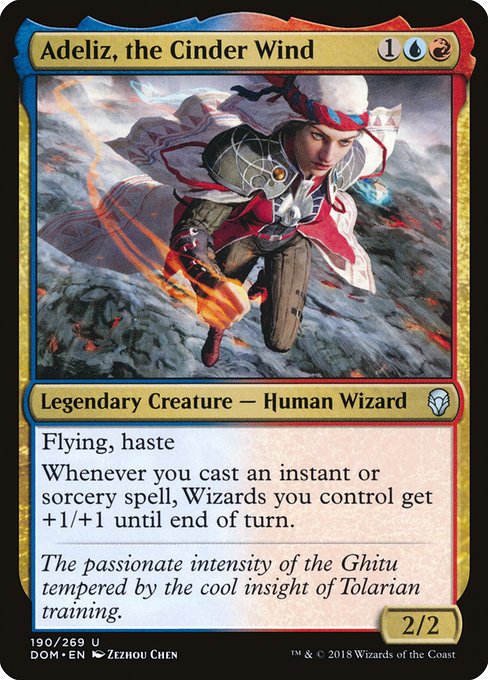
Image courtesy of Scryfall.com
Reading the Signals: How rotation shifts the value and playability of a spell-slinging Wizard
If you’ve spent a night grinding MTG Arena or sorting bulk for a Commander deck, you’ve felt the ache of rotation pulling the rug out from under a favorite strategy. Adeliz, the Cinder Wind—a legendary Human Wizard with a neat package of Flying, Haste, and a continuous buff for Wizards when you sling instant or sorcery spells—is a perfect lens for exploring predictive modeling around rotation impact. With a mana cost of {1}{U}{R}, Adeliz sits at a lean three mana and a striking two-color identity, inviting impulsive starts and tempo-driven gambits. The card’s core mechanic—“Whenever you cast an instant or sorcery spell, Wizards you control get +1/+1 until end of turn”—turns every cheap cantrip into a potential snowball if you’ve lined up a couple of Wizards in play. 🧙♂️🔥💎 From a design perspective, Adeliz embodies a delicate balance: she rewards spell-slinging action without demanding a mega-committal board state. You pay a modest mana cost to trigger a long-term buff for your Wizard tribe, creating a tempo engine that can punish slower opponents who stumble on removal or taps. The flying and haste keywords keep her relevant in fast matchups and quick damage-forward plans, echoing a classic red-blue cadence that many players associate with sneakily efficient “play a spell, threaten a better tomorrow” lines. In the broader ecosystem, Adeliz’s color identity makes her a natural fit for Izzet-inspired decks—where cheap spells and card draw collide with explosive turns. ⚔️🎨 Predictive modeling around rotation asks: when will a card drop out of a major format, and how will that ripple through price, deck viability, and player interest? Adeliz’s Dominarian roots are a reminder that Standard rotates are a catalyst for price volatility, while Modern, Historic, and Commander provide more enduring life for a card’s play pattern. The Dominaria era itself is a treasure-trove of legend and lore that can influence collector sentiment, but it also came with a heavy rotation cycle that often pushes previously iconic cards into a new meta context. In the data, you’ll see modest prices for Adeliz in nonfoil and foil variants—foil collectors do chase these pieces more—yet the average market price remains relatively approachable. That tension—rotation risk vs. evergreen utility—drives the modeling you need for both investment and deck-building decisions. 🧭 As we model rotation impact, we can’t ignore the practical deck-building angle. Adeliz rewards a spell-slugging approach: you want to maximize your flash of value by sequencing instants and sorceries to create forced trades or clean openings. This aligns nicely with a tempo chassis where you want to pressure the opponent with quick turns and midgame threats. The “Wizards you control get +1/+1” aura becomes especially potent when combined with other spell effects that multiply value—draws, bounce, or counters—that you can slip into a single turn. In Commander, she can shine even brighter, especially with a broader Wizard subtheme: as long as the table isn’t ramping into mass removal on your first big swing, Adeliz helps your group of Wizards accumulate damage and draw power in a hurry. And yes, you’ll want to keep an eye on supportive legends and cantrips that let you chain spells without depleting your resources. 🧙♀️🧙♂️ From a practical forecasting standpoint, here are some levers to consider when projecting rotation impact: - Format exposure: Standard rotations spike volatility; Commander tends to stabilize demand, especially for Wizards and spell-slinger synergies. - Rarity and print history: Adeliz is an uncommon from Dominaria with limited reprint risk in the near term, but a future reprint in a Masters set or special anthology could reset expectations. - Card text complexity: The precise wording on trigger conditions matters for modeling accuracy—instant and sorcery-heavy decks tend to keep Adeliz relevant longer than pure creature-based strategies. - Collector dynamics: foil versions carry a premium relative to nonfoil, which can affect price trajectories during surges in interest or in rotation-driven sell-offs. - Cross-format viability: the more formats a card supports (Standard, Historic, Modern, Pioneer, Commander), the more stable its demand across rotation cycles. If you’re testing predictive models, you’ll want to bake in scenario analysis. Base-case projections assume gradual standard rotations with moderate price drift, while optimistic scenarios account for renewed interest in Izzet-y spell-slinger archetypes, plus a Commander meta that mutates around Wizards and spellcasting tempo. Pessimistic scenarios can arise if a significant reprint or a more modern analog with better efficiency surfaces in Standard or Arena’s metagame. The key is to quantify rotation risk alongside evergreen appeal—Adeliz’s core power remains even as formats evolve, and a disciplined model will reflect that reality across time. 🔎 For players, the practical takeaway is clear: when a rotation looms, lean into depth in the rest of your spell suite and plan turn-by-turn innovations rather than chasing a single payoff. Build around cheap cantrips, efficient removal, and a stable Wizard count to ensure that Adeliz remains a meaningful engine, not a one-turn wonder. For collectors, keep one eye on price movements and one eye on print runs. The balance between standard-rotation sensitivity and evergreen playability often yields the most interesting value shifts—and historically, that’s where the real opportunities hide. 💎 Product spotlight: for long nights wrestling with deck decisions and late-night decklists, a reliable desk companion can be a quiet hero. If you’re personalizing your setup for a marathon drafting session or a casual Commander night, consider adding the Neon Gaming Mouse Pad 9x7 Customizable Neoprene Stitch Edges to your rig. It’s a practical, stylish upgrade that won’t break the flow when you’re trying to fix a mana base or pencil in your next big turn. Neon Gaming Mouse Pad 9x7 Customizable Neoprene Stitch EdgesMore from our network
- https://transparent-paper.shop/blog/post/build-personal-development-tracker-templates-that-drive-results/
- https://transparent-paper.shop/blog/post/marketing-data-visualization-best-practices-for-impactful-reports/
- https://crypto-acolytes.xyz/blog/post/top-nintendo-switch-horror-games-you-need-to-play/
- https://blog.digital-vault.xyz/blog/post/strategies-to-collect-customer-testimonials-fast/
- https://blog.digital-vault.xyz/blog/post/undergrowth-leopard-reprints-price-lifecycle-analysis/